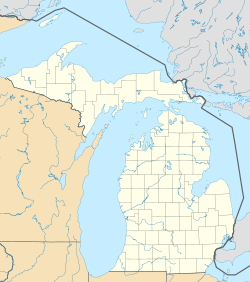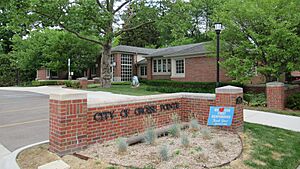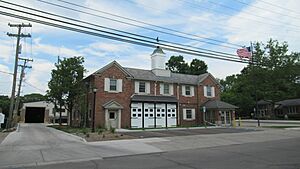Grosse Pointe, Michigan facts for kids
Quick facts for kids
Grosse Pointe, Michigan
|
||
|---|---|---|
| City of Grosse Pointe | ||
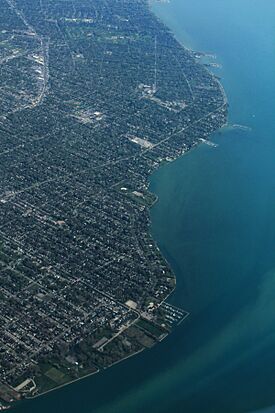
Aerial image of Grosse Pointe
|
||
|
||
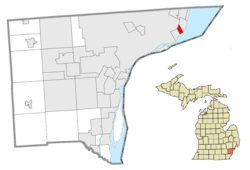
Location of Grosse Pointe in Wayne County
|
||
| Country | ||
| State | ||
| County | Wayne | |
| Incorporated | 1880 (village) 1934 (city) |
|
| Government | ||
| • Type | Mayor–council | |
| Area | ||
| • City | 2.25 sq mi (5.84 km2) | |
| • Land | 1.06 sq mi (2.75 km2) | |
| • Water | 1.19 sq mi (3.09 km2) | |
| Elevation | 587 ft (179 m) | |
| Population
(2020)
|
||
| • City | 5,678 | |
| • Density | 5,346.52/sq mi (2,064.33/km2) | |
| • Metro | 4,285,832 (Metro Detroit) | |
| Time zone | UTC-5 (EST) | |
| • Summer (DST) | UTC-4 (EDT) | |
| ZIP Codes |
48230, 48236
|
|
| Area code(s) | 313 | |
| FIPS code | 26-35480 | |
| GNIS feature ID | 0627461 | |
Grosse Pointe is a city in Wayne County, Michigan, in the United States. It's a suburb located east of Metro Detroit, right along the beautiful Lake St. Clair.
The city shares a small border with Detroit. In 2020, about 5,678 people lived here. Grosse Pointe first became a village in 1880 and then a city in 1934. It is one of five cities that make up the larger Grosse Pointe area.
Contents
Grosse Pointe: A City in Michigan
History of Grosse Pointe
Grosse Pointe officially became a city in 1934. It's one of five cities in the area that share the name "Grosse Pointe." These cities are:
- Grosse Pointe Park
- Grosse Pointe City (this article is about this one!)
- Grosse Pointe Farms
- Grosse Pointe Woods
- Grosse Pointe Shores
The cities of Grosse Pointe, Grosse Pointe Park, and Grosse Pointe Farms are older and have more buildings. They became very popular between 1910 and 1930 as people working in Detroit moved there. Before that, the area had vacation cottages, resorts, farms, and large houses along the lake.
Students from Grosse Pointe, Grosse Pointe Farms, and Grosse Pointe Park attend Grosse Pointe South High School. Students from Grosse Pointe Woods and Grosse Pointe Shores go to Grosse Pointe North High School.
The main shopping area in Grosse Pointe is called "The Village." It's on Kercheval Avenue and many locals consider it the central downtown for all five Grosse Pointes.
Geography and Layout
Grosse Pointe covers about 2.25 square miles (5.84 sq km). About 1.06 square miles (2.75 sq km) is land, and 1.19 square miles (3.09 sq km) is water, which is part of Lake St. Clair.
The city's streets are mostly laid out in a grid pattern. Most blocks have rows of single-family homes built between 1910 and 1950. These homes come in many sizes and styles, from 1,500 to 12,000 square feet (139 to 1,115 sq m). The average size is around 3,000 square feet (279 sq m).
You can see different types of architecture, like neo-Georgian, Tudor revival, Dutch Colonial, and arts and crafts styles. Some older Victorian homes and traditional bungalow homes are also found. There are also townhouses and apartments, many built in the 1920s.
Shopping and office buildings are located along Kercheval Avenue in "The Village" district. You can also find them on Fisher Road near Grosse Pointe South High School and along Mack Avenue, which borders Detroit.
Climate in Grosse Pointe
Grosse Pointe has a humid continental climate. This means it has big differences in temperature throughout the year. Summers are warm to hot and often humid. Winters are cold, and sometimes very cold.
Population and Demographics
The population of Grosse Pointe has changed over the years. Here's how it has grown:
| Historical population | |||
|---|---|---|---|
| Census | Pop. | %± | |
| 1880 | 189 | — | |
| 1890 | 298 | 57.7% | |
| 1900 | 343 | 15.1% | |
| 1910 | 830 | 142.0% | |
| 1920 | 2,084 | 151.1% | |
| 1930 | 5,173 | 148.2% | |
| 1940 | 6,179 | 19.4% | |
| 1950 | 6,283 | 1.7% | |
| 1960 | 6,631 | 5.5% | |
| 1970 | 6,637 | 0.1% | |
| 1980 | 5,901 | −11.1% | |
| 1990 | 5,681 | −3.7% | |
| 2000 | 5,670 | −0.2% | |
| 2010 | 5,421 | −4.4% | |
| 2020 | 5,678 | 4.7% | |
| U.S. Decennial Census | |||
According to the 2010 census, there were 5,421 people living in Grosse Pointe. The average age in the city was 44.7 years. About 26.4% of the population was under 18 years old.
Downtown Development
The city is planning for more growth in its downtown area, known as "The Village." This will allow for more shops and services. For example, two parking lots are planned to be developed into new buildings.
The old Jacobson's Department Store building has been completely updated. It now has offices on the upper floors and new stores, including a Trader Joe's grocery store. A new building also replaced the former Kroger grocery store in 2011.
Education in Grosse Pointe
The Grosse Pointe Public School System runs the public schools in the area.
Lewis Maire Elementary School and Pierce Middle School serve the western part of the city. Père Gabriel Richard Elementary School and Brownell Middle School serve the other half. All students in Grosse Pointe attend Grosse Pointe South High School.
Grosse Pointe is also home to University Liggett School. This is a private school that teaches students from pre-kindergarten all the way through 12th grade.
Notable Places to Visit
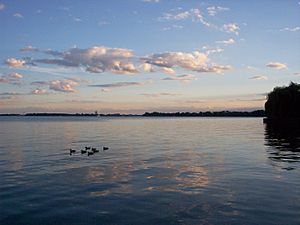
- Neff Park: Located at the end of University Place, this park has a pier and harbor on Lake St. Clair. It also has a pool, playgrounds, picnic areas, volleyball courts, and an ice-skating rink in winter.
- George Elworthy Field: This city park is close to "The Village." It has tennis courts, pickleball courts, sports fields (including Little League Baseball diamonds), and playgrounds.
- Ralph Harmon Booth House: Found at 315 Washington Road, this is the largest house in the city. It's an important English Revival mansion designed by Marcus Burrows.
- Henry Tiffany Cole House: A large and unique Tudor mansion at 394 Lakeland at Maumee.
- John M. Dwyer House: A huge Georgian Colonial mansion at 372 Lakeland.
- Waterman House: A stucco Georgian mansion built in 1911 at 330 Lincoln. It even has a chapel that was brought over from England!
- The Murray Sales House: An Italian villa built in 1917 at 251 Lincoln. It was designed by the famous architect Louis Kamper.
- "Rosecroft," the B. Tobin House: A unique 1912 Tudor-style home designed by Albert Kahn at 266 Lakeland Ave.
- "Woodley Green," the Benson Ford House: This notable Georgian/Regency home was designed by Hugh T. Keyes in 1934 and sits right on the shore of Lake St. Clair.
- Maire Elementary School: The only one of the Grosse Pointe Public Schools located within the city.
- Grosse Pointe Unitarian Church: The only church within the city, located on Maumee near Neff.
Famous People from Grosse Pointe
Many interesting people have connections to Grosse Pointe:
- Gregg Alexander, singer, frontman of the New Radicals
- Anita Baker, singer and eight-time Grammys winner
- Antonio Cipriano, American actor and singer
- Miguel Cabrera, MLB player for the Detroit Tigers
- Roy D. Chapin Jr., former chairman and CEO of American Motors Company
- Laura Devon, actress
- Jeffrey Eugenides, Pulitzer-Prize winning author
- Edsel Ford, automaker
- Edsel Ford II, auto executive
- Elena Ford, auto executive
- Henry Ford II, auto executive
- Martha Firestone Ford, former owner of the Detroit Lions
- William Clay Ford Sr., former owner of the Detroit Lions
- Chris Getz, professional baseball player
- Kirk Gibson, MLB player and former manager
- Jared Lee Gosselin, Grammy-winning music producer
- Julie Harris, actress
- Edward Herrmann, actor
- Hal Hudson, professional baseball pitcher
- John Hughes, famous film director and screenwriter (Home Alone, Ferris Bueller's Day Off)
- Julanne Johnston, silent-film actress
- Maya Joint, professional tennis player
- Bill Kennedy, actor and TV talk show host
- Aaron Krickstein, professional tennis player
- David Legwand, NHL hockey player
- Matt Letscher, actor
- Lisa LoCicero, actress (General Hospital)
- John Lowery, guitarist for several bands
- Debbie Massey, LPGA Tour golfer
- Michael McCarron, professional ice hockey player
- Jim Miller, former NFL quarterback
- Carly Piper, swimmer and Olympic gold medalist
- J.K. Simmons, actor and Academy Award winner (Whiplash)
- Geralin Thomas, organizer and consultant
- Mark Tremonti, guitarist for Creed and Alter Bridge
- Corey Tropp, NHL hockey player
- Zach Werenski, NHL hockey player
- Armani Williams, racing driver
- Ralph Wilson, owner of the Buffalo Bills
See also
 In Spanish: Grosse Pointe (Míchigan) para niños
In Spanish: Grosse Pointe (Míchigan) para niños



